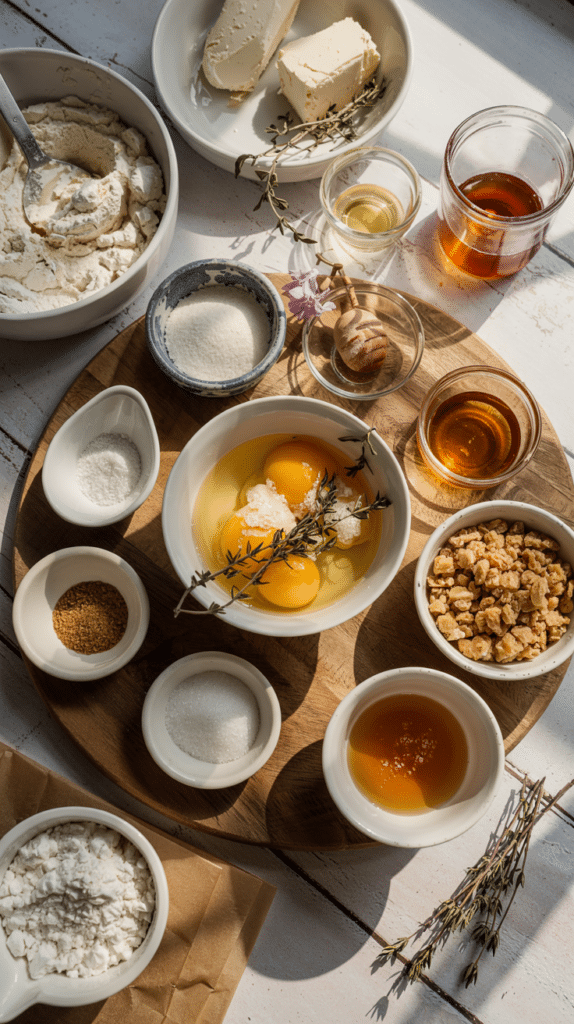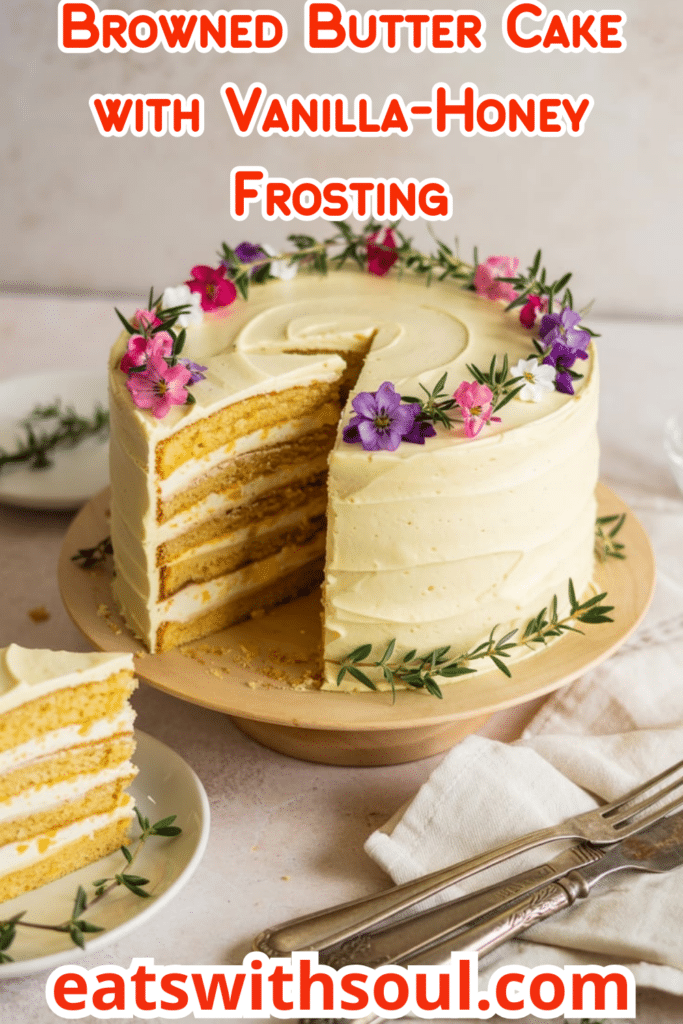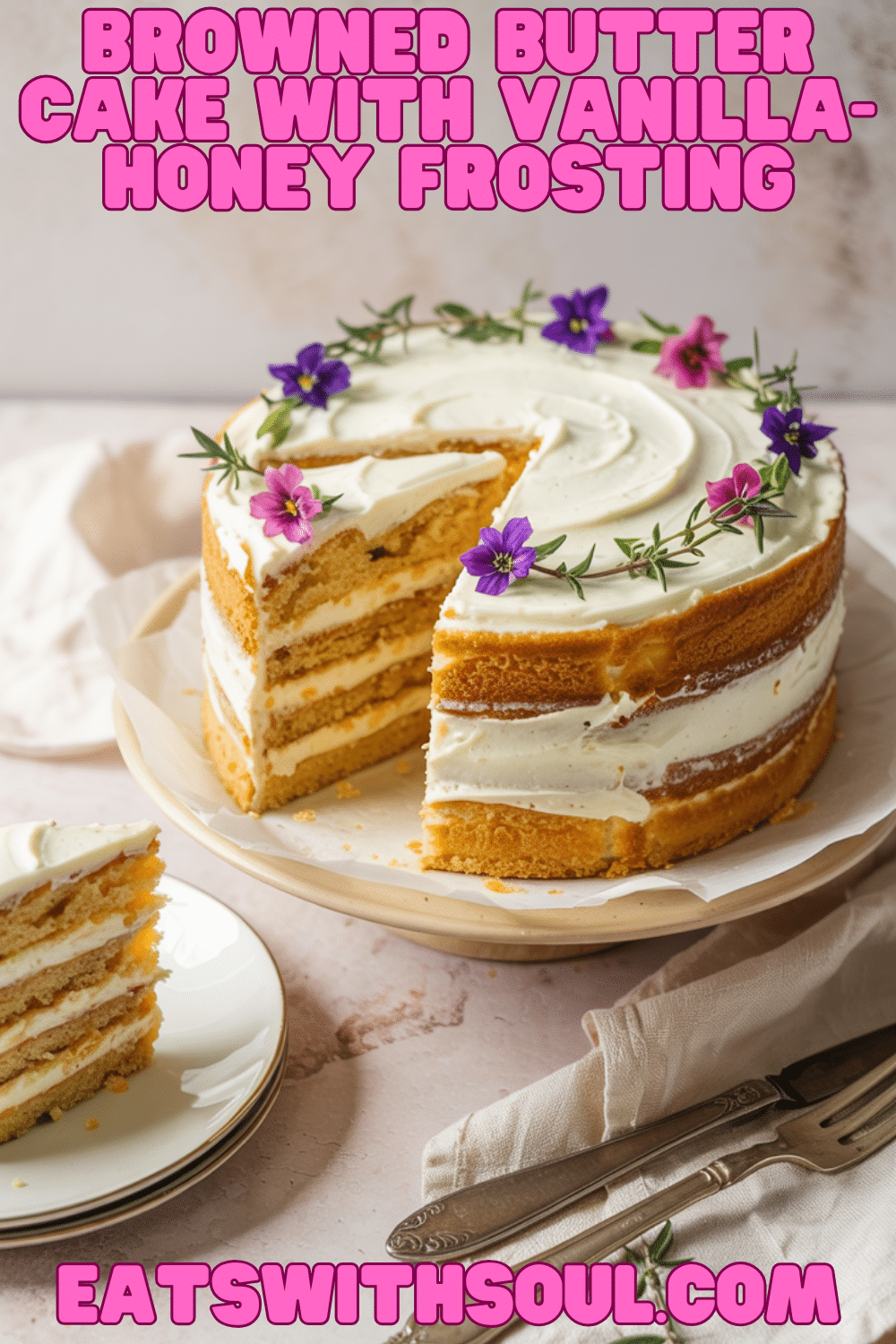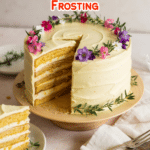Introduction & Inspiration
This Browned Butter Cake is a truly special dessert, offering a depth of flavor that goes beyond a typical butter cake. The process of browning the butter imparts a wonderful nutty, almost caramelized aroma and taste that infuses the tender crumb. Paired with a creamy, tangy vanilla-honey frosting and the unique, sparkling garnish of candied thyme, it’s a cake that feels both rustic and incredibly elegant.
My inspiration for this recipe comes from a love for the nuanced flavor of browned butter and a desire to pair it with complementary tastes like honey and vanilla. The candied thyme adds an unexpected herbal note and a beautiful, sparkling visual element, elevating the cake into something truly memorable.
This cake is perfect for sophisticated celebrations, afternoon tea, or any occasion where you want a dessert that’s subtly complex and beautifully presented. It’s a rewarding bake that showcases interesting flavors and techniques. It is a perfect dessert to impress.
Nostalgic Appeal
While browned butter and candied herbs might feel more modern gourmet than classic childhood cake, the underlying structure – a tender butter cake with cream cheese frosting – taps into deep wells of nostalgic comfort. Butter cakes are reminiscent of home baking, simple pleasures, and comforting treats.
This recipe takes that comforting base and adds layers of sophistication. The nutty browned butter elevates the simple cake, and the honey frosting offers a familiar sweetness with a twist. The candied thyme, while perhaps unusual, adds a touch of whimsical elegance that feels special.
It’s a cake that respects comforting flavors while introducing intriguing new notes, creating a unique blend of familiarity and refinement. A perfect cake, to share with family and friends.
Homemade Focus
This cake is a beautiful example of thoughtful homemade baking. Each component is crafted from scratch, requiring attention to detail. Browning the butter correctly, achieving a tender cake crumb using cake flour, whipping a balanced frosting, and carefully candying fresh thyme sprigs are all part of the rewarding homemade process.
Making the candied thyme, in particular, is a unique homemade touch that transforms a simple herb into a sparkling, edible garnish. Browning the butter is another key technique that requires care but yields incredible flavor depth you won’t find in standard cakes.
This recipe celebrates the nuances that homemade techniques bring. It’s about building layers of flavor and texture from scratch to create something truly exceptional and artisanal. The homemade taste is incredible.
Flavor Goal
The primary flavor goal is a harmonious blend of nutty browned butter, sweet honey, tangy cream cheese, warm vanilla, and a subtle herbal freshness from the candied thyme. The browned butter should provide a distinct nutty, caramelized undertone to the tender cake.
The frosting should be creamy, smooth, and tangy, with the sweetness of the honey complementing the vanilla and balancing the cream cheese. It shouldn’t be overly sweet. The candied thyme garnish adds a surprising textural crunch and a faint herbal aroma that cuts through the richness.
The overall experience should be sophisticated, balanced, and intriguing, with the nutty, sweet, tangy, and herbal notes playing beautifully together against the backdrop of a tender cake crumb. A perfect balance between flavour and texture.
Ingredient Insights
For the Candied Thyme:
- Egg Whites (Beaten Frothy): Act as a light, sticky coating for the sugar to adhere to the thyme sprigs.
- Fresh Thyme Sprigs: Provide the herbal element and the structure for the garnish. Choose fresh, vibrant sprigs.
- Granulated Sugar: Creates the crisp, sparkling candy coating on the thyme.
For the Cake:
- Cake Flour: Lower protein content yields a more tender, delicate crumb compared to all-purpose flour. Sifting is recommended.
- Baking Powder & Baking Soda: Leavening agents for rise and tenderness.
- Salt: Balances sweetness and enhances flavors.
- Superfine Sugar (or Granulated): Sweetens the cake. Superfine dissolves faster but granulated works.
- Unsalted Butter (Browned and Cooled): The star flavor! Browning melts the butterfat and toasts the milk solids, creating a nutty, deep flavor. Must be cooled to avoid cooking the eggs.
- Eggs (Lightly Beaten): Provide structure, richness, and binding. Room temperature preferred.
- Whole Milk: Adds moisture. Room temperature preferred.
- Vanilla Extract: Enhances overall flavor.
For the Vanilla-Honey Frosting:
- Unsalted Butter (Softened): Base of the frosting, adds richness.
- Cream Cheese (Softened): Provides tanginess, creaminess, and structure. Use full-fat, brick-style, properly softened.
- Honey: Adds sweetness and distinct floral/warm flavor notes.
- Powdered Sugar (Sifted): Provides sweetness and structure. Sifting prevents lumps. The amount is adjustable for consistency.
- Vanilla Extract: Complements the honey and cream cheese.
- Milk (As Needed): To adjust the frosting consistency.
For Garnishes:
- Candied Thyme Sprigs: The homemade sparkly garnish.
- Edible Flowers (Optional): Add extra color and elegance.
Essential Equipment
- Small Bowl & Whisk/Fork: For frothing egg whites for thyme.
- Baking Sheet & Cooling Rack: For drying candied thyme.
- Saucepan (Preferably Light-Colored): Essential for browning the butter evenly and monitoring the color change.
- Mixing Bowls (Multiple Sizes): For cake dry ingredients, wet ingredients, frosting.
- Whisk: For dry ingredients, combining wet cake ingredients.
- Electric Mixer (Stand Mixer with Paddle or Handheld): Essential for making the frosting smooth and fluffy. Can be used for cake batter too.
- Three Cake Pans: Recipe doesn’t specify size, but based on batter volume, likely 8-inch or possibly 9-inch round pans.
- Parchment Paper: For lining cake pans.
- Rubber Spatula: For scraping bowls.
- Wire Cooling Racks: For cooling cake layers completely.
- Offset Spatula: For frosting the cake.
- Cake Stand or Serving Platter:
Ingredients
Candied Thyme:
- ▢ 2 egg whites, beaten until frothy
- ▢ 20 thyme sprigs
- ▢ 1 cup granulated sugar
Cake:
- ▢ 3 cups cake flour, sifted
- ▢ 1 ½ teaspoon baking powder
- ▢ ¾ teaspoon baking soda
- ▢ ½ teaspoon salt
- ▢ 1 ¾ cups superfine sugar (or granulated)
- ▢ 1 cup unsalted butter, browned and cooled (see step 1 below)
- ▢ 3 large eggs, lightly beaten (room temperature preferred)
- ▢ 1 ½ cups whole milk (room temperature preferred)
- ▢ 2 teaspoons vanilla extract
Vanilla-Honey Frosting:
- ▢ ½ cup (1 stick) unsalted butter, softened
- ▢ 4 ounces cream cheese, softened
- ▢ 2 tablespoons honey
- ▢ 2 ½ to 3 cups powdered sugar, sifted
- ▢ 1 teaspoon vanilla extract
- ▢ milk, as needed (1 tablespoon at a time)
Garnishes:
- ▢ Candied thyme sprigs (from above)
- ▢ Edible flowers (optional)

Step-by-Step Instructions
1. Make the Candied Thyme:
- Prepare the candied thyme first to allow drying time. In a small bowl, beat the egg whites until just frothy.
- Place the 1 cup of granulated sugar in a shallow dish or plate.
- Fully dip each fresh thyme sprig into the frothed egg whites, letting excess drip off.
- Carefully dredge each coated sprig in the sugar until fully coated, shaking off any excess sugar.
- Place each coated thyme sprig onto a wire rack set over a baking sheet. Allow the sprigs to air dry completely until crisp, at least 1 hour, or ideally longer (can be made 1-2 days ahead and stored carefully in an airtight container once dry).
2. Brown the Butter:
- Place the 1 cup (2 sticks) of unsalted butter in a medium, light-colored saucepan over medium heat.
- Melt the butter, then continue cooking, swirling the pan occasionally. The butter will foam, then subside. Watch carefully as golden brown specks (toasted milk solids) begin to form at the bottom and the butter develops a nutty aroma.
- Once the butter is amber brown and smells nutty (this can take 5-10 minutes), immediately remove it from the heat and pour it into a heatproof bowl to stop the cooking. Be careful not to burn the solids.
- Let the browned butter cool completely to room temperature before using in the cake batter.
3. Prepare Oven and Pans:
- Preheat oven to 350°F (175°C).
- Prepare three cake pans (likely 8-inch or 9-inch rounds) by greasing them and lining the bottoms with parchment paper circles. Grease the parchment as well.
4. Mix Cake Batter:
- In a large mixing bowl, sift or whisk together the cake flour, baking powder, baking soda, and salt.
- In another large mixing bowl, whisk together the superfine (or granulated) sugar, the cooled browned butter, and the lightly beaten eggs until combined.
- Pour the flour mixture into the egg/butter mixture and whisk together until very thick and just combined.
- Stir in the whole milk and vanilla extract until fully incorporated and the batter is smooth. Do not overmix.
5. Bake the Cakes:
- Pour the batter evenly into the three prepared cake pans.
- Bake for 25 to 30 minutes, or until a toothpick inserted into the center of the cake comes out clean.
- Allow the cakes to cool in the pans on wire racks for 15 to 20 minutes.
- Carefully invert the cakes onto the wire racks, remove the parchment paper, and allow them to cool completely.
6. Make the Vanilla-Honey Frosting:
- Ensure butter and cream cheese are properly softened.
- Place the softened butter, softened cream cheese, and honey into the bowl of a stand mixer fitted with the paddle attachment (or use an electric hand mixer).
- Whip on medium-high speed until light and fluffy.
- Reduce speed to low. Gradually add the sifted powdered sugar, ½ cup at a time, mixing until fully incorporated after each addition.
- Add the vanilla extract. Increase speed to medium-high and continue to beat until the frosting is very light and fluffy.
- Check consistency: If the frosting seems too stiff, beat in milk, 1 tablespoon at a time, until it reaches a smooth, spreadable consistency.
7. Assemble the Cake:
- If necessary, level the tops of the cooled cake layers. Place the first layer on your serving plate or cake stand.
- Spread a thin, even layer of the vanilla-honey frosting over the top.
- Place the second cake layer on top, inverted (bottom side up, if leveled) or right side up. Spread another layer of frosting.
- Place the third cake layer on top (preferably inverted for a flat top).
- Apply a thin “crumb coat” of frosting over the entire cake (top and sides) to seal in crumbs. Chill for 15-20 minutes.
8. Final Frosting and Decoration:
- Apply the remaining frosting smoothly or decoratively over the top and sides of the chilled cake using an offset spatula.
- Gently place a ‘crown’ of candied thyme sprigs around the base and/or top edge of the cake.
- Add edible flowers for extra decoration, if desired.
- Let the cake sit briefly before serving, or store refrigerated (let come towards room temp before serving).

Troubleshooting
- Butter Burned: Browned butter can go from perfect to burnt quickly. Watch carefully, use a light-colored pan, and remove from heat immediately once nutty and amber. If it burns (black specks, burnt smell), discard and start over.
- Cake Dry/Dense: Overbaking, overmixing, or butter too hot when added. Use cake flour, mix minimally, check doneness early. Ensure browned butter is fully cooled.
- Frosting Too Soft/Stiff: Adjust consistency carefully with sifted powdered sugar (if too soft) or milk (if too stiff). Ensure butter/cream cheese were properly softened but not melty. Honey adds moisture, so start with less powdered sugar if unsure.
- Candied Thyme Sticky/Not Drying: Needs more drying time, or humidity is too high. Ensure egg white coating was thin. Store airtight once fully dry.
Tips and Variations
- Brown Butter Carefully: Don’t walk away! The nutty aroma and amber color are key indicators. Pour it out immediately to stop cooking.
- Room Temp Ingredients: Important for cake (eggs, milk) and frosting (butter, cream cheese) for best texture.
- Cake Flour: Provides a tender crumb, recommended over all-purpose for this recipe.
- Candied Herbs: You can candy other sturdy herbs like rosemary using the same method for a different garnish.
- Nuts: Add toasted chopped pecans or walnuts to the cake batter or sprinkle between layers.
- Simplify Garnish: Skip the candied thyme and just use edible flowers or a drizzle of honey.
Serving and Pairing Suggestions
- Serve at Cool Room Temperature: Allows cake and frosting flavors/textures to be optimal.
- Elegant Occasions: Perfect for showers, brunches, dinner parties, spring/summer celebrations.
- With Tea or Coffee: Complements the nutty and sweet flavors.
- With Fresh Fruit: A side of simple berries or sliced peaches would be lovely.
Nutritional Information
(Note: Estimated, per slice, assuming 12 slices)
- Calories: 500-650+
- Fat: 30-40g+
- Saturated Fat: 18-25g+
- Cholesterol: 100-140mg+
- Sodium: 150-250mg+
- Total Carbohydrates: 55-70g+
- Dietary Fiber: <1g
- Sugars: 40-55g+
- Protein: 5-7g+
Elegant Browned Butter Cake with Vanilla-Honey Frosting & Candied Thyme
Bake a sophisticated Browned Butter Cake! This recipe features a tender cake made with nutty browned butter, frosted with a creamy vanilla-honey cream cheese frosting, and garnished with elegant candied thyme.
Ingredients
Candied Thyme:
- ▢ 2 egg whites, beaten until frothy
- ▢ 20 thyme sprigs
- ▢ 1 cup granulated sugar
Cake:
- ▢ 3 cups cake flour, sifted
- ▢ 1 ½ teaspoon baking powder
- ▢ ¾ teaspoon baking soda
- ▢ ½ teaspoon salt
- ▢ 1 ¾ cups superfine sugar (or granulated)
- ▢ 1 cup unsalted butter, browned and cooled (see step 1 below)
- ▢ 3 large eggs, lightly beaten (room temperature preferred)
- ▢ 1 ½ cups whole milk (room temperature preferred)
- ▢ 2 teaspoons vanilla extract
Vanilla-Honey Frosting:
- ▢ ½ cup (1 stick) unsalted butter, softened
- ▢ 4 ounces cream cheese, softened
- ▢ 2 tablespoons honey
- ▢ 2 ½ to 3 cups powdered sugar, sifted
- ▢ 1 teaspoon vanilla extract
- ▢ milk, as needed (1 tablespoon at a time)
Garnishes:
- ▢ Candied thyme sprigs (from above)
- ▢ Edible flowers (optional)
Instructions
1. Make the Candied Thyme:
- Prepare the candied thyme first to allow drying time. In a small bowl, beat the egg whites until just frothy.
- Place the 1 cup of granulated sugar in a shallow dish or plate.
- Fully dip each fresh thyme sprig into the frothed egg whites, letting excess drip off.
- Carefully dredge each coated sprig in the sugar until fully coated, shaking off any excess sugar.
- Place each coated thyme sprig onto a wire rack set over a baking sheet. Allow the sprigs to air dry completely until crisp, at least 1 hour, or ideally longer (can be made 1-2 days ahead and stored carefully in an airtight container once dry).
2. Brown the Butter:
- Place the 1 cup (2 sticks) of unsalted butter in a medium, light-colored saucepan over medium heat.
- Melt the butter, then continue cooking, swirling the pan occasionally. The butter will foam, then subside. Watch carefully as golden brown specks (toasted milk solids) begin to form at the bottom and the butter develops a nutty aroma.
- Once the butter is amber brown and smells nutty (this can take 5-10 minutes), immediately remove it from the heat and pour it into a heatproof bowl to stop the cooking. Be careful not to burn the solids.
- Let the browned butter cool completely to room temperature before using in the cake batter.
3. Prepare Oven and Pans:
- Preheat oven to 350°F (175°C).
- Prepare three cake pans (likely 8-inch or 9-inch rounds) by greasing them and lining the bottoms with parchment paper circles. Grease the parchment as well.
4. Mix Cake Batter:
- In a large mixing bowl, sift or whisk together the cake flour, baking powder, baking soda, and salt.
- In another large mixing bowl, whisk together the superfine (or granulated) sugar, the cooled browned butter, and the lightly beaten eggs until combined.
- Pour the flour mixture into the egg/butter mixture and whisk together until very thick and just combined.
- Stir in the whole milk and vanilla extract until fully incorporated and the batter is smooth. Do not overmix.
5. Bake the Cakes:
- Pour the batter evenly into the three prepared cake pans.
- Bake for 25 to 30 minutes, or until a toothpick inserted into the center of the cake comes out clean.
- Allow the cakes to cool in the pans on wire racks for 15 to 20 minutes.
- Carefully invert the cakes onto the wire racks, remove the parchment paper, and allow them to cool completely.
6. Make the Vanilla-Honey Frosting:
- Ensure butter and cream cheese are properly softened.
- Place the softened butter, softened cream cheese, and honey into the bowl of a stand mixer fitted with the paddle attachment (or use an electric hand mixer).
- Whip on medium-high speed until light and fluffy.
- Reduce speed to low. Gradually add the sifted powdered sugar, ½ cup at a time, mixing until fully incorporated after each addition.
- Add the vanilla extract. Increase speed to medium-high and continue to beat until the frosting is very light and fluffy.
- Check consistency: If the frosting seems too stiff, beat in milk, 1 tablespoon at a time, until it reaches a smooth, spreadable consistency.
7. Assemble the Cake:
- If necessary, level the tops of the cooled cake layers. Place the first layer on your serving plate or cake stand.
- Spread a thin, even layer of the vanilla-honey frosting over the top.
- Place the second cake layer on top, inverted (bottom side up, if leveled) or right side up. Spread another layer of frosting.
- Place the third cake layer on top (preferably inverted for a flat top).
- Apply a thin “crumb coat” of frosting over the entire cake (top and sides) to seal in crumbs. Chill for 15-20 minutes.
8. Final Frosting and Decoration:
- Apply the remaining frosting smoothly or decoratively over the top and sides of the chilled cake using an offset spatula.
- Gently place a ‘crown’ of candied thyme sprigs around the base and/or top edge of the cake.
- Add edible flowers for extra decoration, if desired.
- Let the cake sit briefly before serving, or store refrigerated (let come towards room temp before serving).
Recipe Summary and Q&A
Summary: This Browned Butter Cake features tender cake layers flavored with nutty browned butter, filled and frosted with a vanilla-honey cream cheese frosting, and uniquely garnished with homemade candied thyme sprigs. The process involves candying thyme, browning butter, baking the cake layers, making the frosting, and assembling/decorating the cake.
Q&A:
- Q: Do I have to brown the butter? Can I just use melted or softened butter?
- A: Browning the butter is essential for the signature nutty flavor of this cake. Using regular melted or softened butter will result in a standard butter cake, losing the unique flavor profile.
- Q: Is the candied thyme difficult to make?
- A: It’s not difficult, just a bit meticulous and requires drying time. Ensure the egg white coating is thin and the sugar coating is even. Let dry completely until crisp.
- Q: Can I make this cake ahead of time?
- A: Yes. Bake cake layers, cool, wrap well (room temp 1 day or freeze). Make candied thyme ahead (store airtight). Make frosting ahead, refrigerate (bring to room temp, re-whip). Assemble the cake the day of or day before serving. Add candied thyme closer to serving time as it can absorb moisture from the frosting.
- Q: Can I use all-purpose flour instead of cake flour?
- A: Cake flour is recommended for a more tender result. If substituting AP flour, consider using the method of replacing 2 tbsp flour with 2 tbsp cornstarch per cup.

